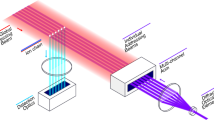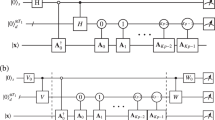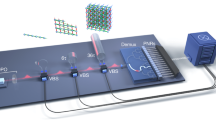Abstract
Solving computationally hard problems using conventional computing architectures is often slow and energetically inefficient. Quantum computing may help with these challenges, but it is still in the early stages of development. A quantum-inspired alternative is to build domain-specific architectures with classical hardware. Here we report a sparse Ising machine that achieves massive parallelism where the flips per second—the key figure of merit—scales linearly with the number of probabilistic bits. Our sparse Ising machine architecture, prototyped on a field-programmable gate array, is up to six orders of magnitude faster than standard Gibbs sampling on a central processing unit, and offers 5–18 times improvements in sampling speed compared with approaches based on tensor processing units and graphics processing units. Our sparse Ising machine can reliably factor semi-primes up to 32 bits and it outperforms competition-winning Boolean satisfiability solvers in approximate optimization. Moreover, our architecture can find the correct ground state, even when inexact sampling is made with faster clocks. Our problem encoding and sparsification techniques could be applied to other classical and quantum Ising machines, and our architecture could potentially be scaled to 1,000,000 or more p-bits using analogue silicon or nanodevice technologies.
This is a preview of subscription content, access via your institution
Access options
Access Nature and 54 other Nature Portfolio journals
Get Nature+, our best-value online-access subscription
$29.99 / 30 days
cancel any time
Subscribe to this journal
Receive 12 digital issues and online access to articles
$119.00 per year
only $9.92 per issue
Buy this article
- Purchase on Springer Link
- Instant access to full article PDF
Prices may be subject to local taxes which are calculated during checkout





Similar content being viewed by others
Data availability
The data that support the plots within this paper and other findings of this study are available from the corresponding authors upon reasonable request.
Code availability
The computer code and problem instances used in this study are available from the corresponding authors upon reasonable request.
References
Metropolis, N., Rosenbluth, A. W., Rosenbluth, M. N., Teller, A. H. & Teller, E. Equation of state calculations by fast computing machines. J. Chem. Phys. 21, 1087–1092 (1953).
Buluc, A. et al. Randomized algorithms for scientific computing (RASC). Preprint at https://arxiv.org/abs/2104.11079 (2021).
Hinton, G. E. A practical guide to training restricted Boltzmann machines. in Neural Networks: Tricks of the Trade 599–619 (Springer, 2012).
Mansinghka, V. K., Jonas, E. M. & Tenenbaum, J. B. Stochastic Digital Circuits for Probabilistic Inference. Report No. MITCSAIL-TR (Massachussets Institute of Technology, 2008).
Bouchard-Côté, A., J Vollmer, S. & Doucet, A. The bouncy particle sampler: a nonreversible rejection-free Markov chain Monte Carlo method. J. Am. Stat. Assoc. 113, 855–867 (2018).
Kirkpatrick, S., Gelatt, C. D. & Vecchi, M. P. Optimization by simulated annealing. Science 220, 671–680 (1983).
McMahon, P. L. et al. A fully programmable 100-spin coherent Ising machine with all-to-all connections. Science 354, 614–617 (2016).
Yamaokam, M. et al. 24.3 20k-spin Ising chip for combinational optimization problem with CMOS annealing. In 2015 IEEE International Solid-State Circuits Conference—(ISSCC) Digest of Technical Papers 1–3 (IEEE, 2015).
Goto, H., Tatsumura, K. & Dixon, A. R. Combinatorial optimization by simulating adiabatic bifurcations in nonlinear Hamiltonian systems. Sci. Adv. 5, eaav2372 (2019).
Wang, T. & Roychowdhury, J. OIM: oscillator-based Ising machines for solving combinatorial optimisation problems. In International Conference on Unconventional Computation and Natural Computation 232–256 (Springer, 2019).
Ahmed, I., Chiu, P.-W. & Kim, C. H. A probabilistic self-annealing compute fabric based on 560 hexagonally coupled ring oscillators for solving combinatorial optimization problems. In 2020 IEEE Symposium on VLSI Circuits 1–2 (IEEE, 2020).
Dutta, S. et al. An Ising Hamiltonian solver based on coupled stochastic phase-transition nano-oscillators. Nat. Electron. 4, 502–512 (2021).
Borders, W. A. et al. Integer factorization using stochastic magnetic tunnel junctions. Nature 573, 390–393 (2019).
Aramon, M. et al. Physics-inspired optimization for quadratic unconstrained problems using a digital annealer. Front. Phys. 7, 48 (2019).
Yamamoto, K. et al. 7.3 STATICA: a 512-spin 0.25M-weight full-digital annealing processor with a near-memory all-spin-updates-at-once architecture for combinatorial optimization with complete spin-spin interactions. In 2020 IEEE International Solid-State Circuits Conference—(ISSCC) 138–140 (IEEE, 2020).
Patel, S., Canoza, P. & Salahuddin, S. Logically synthesized and hardware-accelerated restricted Boltzmann machines for combinatorial optimization and integer factorization. Nat. Electron. 5, 92–101 (2022).
Su, Y., Mu, J., Kim, H. & Kim, B. A 252 spins scalable CMOS Ising chip featuring sparse and reconfigurable spin interconnects for combinatorial optimization problems. In 2021 IEEE Custom Integrated Circuits Conference (CICC) 1–2 (IEEE, 2021).
Smithson, S. et al. Efficient CMOS invertible logic using stochastic computing. IEEE Trans. Circuits Syst. I, Reg. Papers 66, 2263–2274 (2019).
Cai, F. et al. Power-efficient combinatorial optimization using intrinsic noise in memristor Hopfield neural networks. Nat. Electron. 3, 409–418 (2020).
Tatsumura, K., Yamasaki, M. & Goto, H. Scaling out Ising machines using a multi-chip architecture for simulated bifurcation. Nat. Electron. 4, 208–217 (2021).
Dixit, V., Selvarajan, R., Alam, M. A., Humble, T. S. & Kais, S. Training restricted Boltzmann machines with a D-Wave quantum annealer. Front. Phys. 9, 589626 (2021).
Koller D. & Friedman, N. Probabilistic Graphical Models: Principles and Techniques (MIT Press, 2009).
Finocchio, G. et al. The promise of spintronics for unconventional computing. J. Magn. Magn. Mater. 521, 167506 (2021).
Andriyash, E. et al. Boosting Integer Factoring Performance via Quantum Annealing Offsets. Report No. 14 (D-Wave Technical Report Series, 2016).
Dridi, R. & Alghassi, H. Prime factorization using quantum annealing and computational algebraic geometry. Sci. Rep. 7, 43048 (2017).
Jiang, S., Britt, K. A., McCaskey, A. J., S Humble, T. & Kais, S. Quantum annealing for prime factorization. Sci. Rep. 8, 17667 (2018).
Lucas, A. Ising formulations of many NP problems. Front. Phys. 2, 5 (2014).
Camsari, K. Y. et al. Stochastic p-bits for invertible logic. Phys. Rev. X 7, 031014 (2017).
Onizawa, N. et al. A design framework for invertible logic. In 2019 53rd Asilomar Conference on Signals, Systems, and Computers 312–316 (IEEE, 2019).
Brélaz, D. New methods to color the vertices of a graph. Commun. ACM 22, 251–256 (1979).
De Sa, C., Re, C. & Olukotun, K. Ensuring rapid mixing and low bias for asynchronous Gibbs sampling. In Proc. 33rd International Conference on Machine Learning 1567–1576 (PMLR, 2016).
Ko, G. G., Chai, Y., Rutenbar, R. A., Brooks, D. & Wei, G.-Y. FlexGibbs: reconfigurable parallel Gibbs sampling accelerator for structured graphs. In 2019 IEEE 27th Annual International Symposium on Field-Programmable Custom Computing Machines (FCCM) 334 (IEEE, 2019).
Fang, Y. et al. Parallel tempering simulation of the three-dimensional Edwards–Anderson model with compact asynchronous multispin coding on GPU. Comput. Phys. Commun. 185, 2467–2478 (2014).
Yang, K., Chen, Y.-F., Roumpos, G., Colby, C. & Anderson, J. High performance Monte Carlo simulation of Ising model on TPU clusters. In Proc. International Conference for High Performance Computing, Networking, Storage and Analysis 83 (ACM, 2019).
Yoshimura, C., Hayashi, M., Okuyama, T. & Yamaoka, M. FPGA-based annealing processor for Ising model. In 2016 Fourth International Symposium on Computing and Networking (CANDAR) 436–442 (IEEE, 2016).
Kaminsky, W. M. & Lloyd, S. Scalable architecture for adiabatic quantum computing of NP-hard problems. in Quantum Computing and Quantum Bits in Mesoscopic Systems 229–236 (Springer, 2004).
Block, B., Virnau, P. & Preis, T. Multi-GPU accelerated multi-spin Monte Carlo simulations of the 2D Ising model. Comput. Phys. Commun. 181, 1549–1556 (2010).
Preis, T., Virnau, P., Paul, W. & Schneider, J. J. GPU accelerated Monte Carlo simulation of the 2D and 3D Ising model. J. Comput. Phys. 228, 4468–4477 (2009).
Bhatti, S. et al. Spintronics based random access memory: a review. Mater. Today 20, 530–548 (2017).
Safranski, C. et al. Demonstration of nanosecond operation in stochastic magnetic tunnel junctions. Nano Lett. 21, 2040–2045 (2021).
Hayakawa, K. et al. Nanosecond random telegraph noise in in-plane magnetic tunnel junctions. Phys. Rev. Lett. 126, 117202 (2021).
Sutton, B. et al. Autonomous probabilistic coprocessing with petaflips per second. IEEE Access 8, 157238–157252 (2020).
Mohseni, M. et al. Nonequilibrium Monte Carlo for unfreezing variables in hard combinatorial optimization. Preprint at https://arxiv.org/abs/2111.13628 (2021).
Mosca, M., Marcos Vensi Basso, J. & Verschoor, S. R. On speeding up factoring with quantum SAT solvers. Sci. Rep. 10, 15022 (2020).
Hoos, H. H. & Stützle, T. SATLIB: an online resource for research on SAT. Sat 2000, 283–292 (2000).
Fleury, A. B. K. F. M. & Heisinger, M. CaDiCaL, KISSAT, PARACOOBA, PLINGELING and TREENGELING entering the SAT competition 2020. SAT COMPETITION 2020, 50 (2020).
Soos, M., Devriendt, J., Gocht, S., Shaw, A. & Meel, K. S. CryptoMiniSat with CCAnr at the SAT competition 2020. SAT COMPETITION 2020, 27 (2020).
Zhang, X., Bashizade, R., Wang, Y., Mukherjee, S. & Lebeck, A. R. Statistical robustness of Markov chain Monte Carlo accelerators. In Proc. 26th ACM International Conference on Architectural Support for Programming Languages and Operating Systems 959–974 (ACM, 2021).
Biere, A. CaDiCaL, LINGELING, PLINGELING, TREENGELING and YALSAT entering the SAT competition 2017. In Proc. SAT Competition 13–14 (2017).
Acknowledgements
We are grateful to B. M. Sutton, D. Eppens, A. Ho and M. Mohseni for useful discussions. N.A.A. is grateful to G. Eschemann for useful discussions on airhdl. We acknowledge Xilinx for the hardware support. K.Y.C. and L.T. acknowledge support from the Institute of Energy Efficiency, University of California, Santa Barbara. K.Y.C. and N.A.A. acknowledge support from the National Science Foundation through CCF 2106260. The research of A.G., M.C. and G.F. has been supported by project no. PRIN 2020LWPKH7 funded by the Italian Ministry of University and Research and by Petaspin association (https://www.petaspin.com/). Computational facilities were purchased with funds from the National Science Foundation (CNS-1725797) and administered by the Center for Scientific Computing (CSC). The CSC is supported by the California NanoSystems Institute and the Materials Research Science and Engineering Center (MRSEC; NSF DMR 1720256) at University of California, Santa Barbara.
Author information
Authors and Affiliations
Contributions
N.A.A. and K.Y.C. conceived the idea and planned the study. N.A.A. set up the FPGA and performed the experimental measurements. A.G., N.A.A., G.F. and K.Y.C. performed the data analysis. All the authors have participated in useful discussions and in writing the manuscript.
Corresponding authors
Ethics declarations
Competing interests
The authors declare no competing interests.
Peer review
Peer review information
Nature Electronics thanks Kosuke Tatsumura, Masanao Yamaoka and the other, anonymous, reviewer(s) for their contribution to the peer review of this work.
Additional information
Publisher’s note Springer Nature remains neutral with regard to jurisdictional claims in published maps and institutional affiliations.
Supplementary information
Supplementary Information
Supplementary Discussion, Figs. 1–9 and Tables 1 and 2.
Rights and permissions
About this article
Cite this article
Aadit, N.A., Grimaldi, A., Carpentieri, M. et al. Massively parallel probabilistic computing with sparse Ising machines. Nat Electron 5, 460–468 (2022). https://doi.org/10.1038/s41928-022-00774-2
Received:
Accepted:
Published:
Issue Date:
DOI: https://doi.org/10.1038/s41928-022-00774-2
This article is cited by
-
CMOS plus stochastic nanomagnets enabling heterogeneous computers for probabilistic inference and learning
Nature Communications (2024)
-
Enhanced convergence in p-bit based simulated annealing with partial deactivation for large-scale combinatorial optimization problems
Scientific Reports (2024)
-
Point convolutional neural network algorithm for Ising model ground state research based on spring vibration
Scientific Reports (2024)
-
CMOS-compatible ising machines built using bistable latches coupled through ferroelectric transistor arrays
Scientific Reports (2023)
-
Accelerated quantum Monte Carlo with probabilistic computers
Communications Physics (2023)



